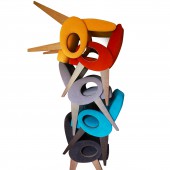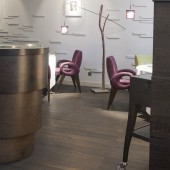
| THE AWARD |
| CATEGORIES |
| REGISTRATION |
| SUBMIT YOUR WORK |
| ENTRY INSTRUCTIONS |
| TERMS & CONDITIONS |
| PUBLICATIONS |
| DATES & FEES |
| METHODOLOGY |
| CONTACT |
| WINNERS |
| PRESS ROOM |
| GET INVOLVED |
| DESIGN PRIZE |
| DESIGN STORE |
| THE AWARD | JURY | CATEGORIES | REGISTRATION | PRESS | WINNERS | PUBLICATIONS | ENTRY INSTRUCTIONS |
Ami Bridge Armchair by Patrick Sarran |
Home > Winners > Design #45208 >Interview |
 |
|
FS: What is the main principle, idea and inspiration behind your design?
PS: Watching a rugby match here in Toulouse, the rugby capital of France, I got the idea of using as a main motif the distinctive oval shape of a rugby ball.
FS: What has been your main focus in designing this work? Especially what did you want to achieve?
PS: In 2010, my brother asked me to create 60 new armchairs for his restaurant. He needed something new, colored, comfortable, strong and stain-resistant. I decided to make a wraparound chair, with the constraint of a low scale production in my workshop.
FS: What are your future plans for this award winning design?
PS: Every designer must designed a chair. I hope this one will continue to be successful.
FS: How long did it take you to design this particular concept?
PS: Six months.
FS: Why did you design this particular concept? Was this design commissioned or did you decide to pursuit an inspiration?
PS: I designed this armchair for my brother, and edit it by QUISO.
FS: Is your design being produced or used by another company, or do you plan to sell or lease the production rights or do you intent to produce your work yourself?
PS: AMI is used by QUISO, my own company; Maybe in the future I will need a partner.
FS: What made you design this particular type of work?
PS: I wanted something very exclusive for my brother.
FS: Where there any other designs and/or designers that helped the influence the design of your work?
PS: Always Jean Prouvé. This designer was a manufacturer too. He followed simpler ways from the function to the form as from his craft. As him I designed this chair with the goal to produce it in my workshop, not in a specialized factory. There are common points in the approach, and also in the shapes of our both designs. Massive legs of AMI chair have evident similarities with those of Jean Prouvé pieces.
FS: Who is the target customer for his design?
PS: Restaurants, hotels.
FS: What sets this design apart from other similar or resembling concepts?
PS: The design combines oval and square shapes. The elliptic holes in the arms are lined by moulded pieces of wood that people enjoy stroking.
FS: How did you come up with the name for this design? What does it mean?
PS: AMI in french means Friend and remind me of Michel my brother.
FS: Which design tools did you use when you were working on this project?
PS: I simultaneously use the software Vectorworks and my cabinet maker workshop.
FS: What is the most unique aspect of your design?
PS: The profile with oval shapes in bright colors contrasting with its massive legs
FS: Who did you collaborate with for this design? Did you work with people with technical / specialized skills?
PS: I made two simplified prototypes that I presented to my brother, Chef Michel Sarran in his 2-star restaurant. He and the more corpulent members of his staff tested comfort and criticized various aspects such as handling ability, weight and aesthetics. In this interactive process I had to optimize the size of the armchair, both for better comfort and also for better adaptation to the capacity of the restaurant.
FS: What is the role of technology in this particular design?
PS: Several pieces inside are cut using water jet and laser machines.
FS: Is your design influenced by data or analytical research in any way? What kind of research did you conduct for making this design?
PS: There was no data used during the early stages but a lot research went into the type of materials, components and shape of design.
FS: What are some of the challenges you faced during the design/realization of your concept?
PS: Making an affordable quality chair in short series is difficult for a craftsman. I had to take in account this constraint in my design. Fortunately I had two good subcontractors nearby, an upholsterer and a sheet metal factory equipped with laser and water jet machines that could also be used for wood panels.
FS: How did you decide to submit your design to an international design competition?
PS: One day, I found the proposal to participate to A’Design Award in my mail box. I did not know this competition. After I read the rules and the methodology of the contest, I told myself, why not?
FS: What did you learn or how did you improve yourself during the designing of this work?
PS: I develop methods allowing me to produce chairs in short series.
FS: Any other things you would like to cover that have not been covered in these questions?
PS: no.
FS: Thank you for providing us with this opportunity to interview you.
A' Design Award and Competitions grants rights to press members and bloggers to use parts of this interview. This interview is provided as it is; DesignPRWire and A' Design Award and Competitions cannot be held responsible for the answers given by participating designers.
| SOCIAL |
| + Add to Likes / Favorites | Send to My Email | Comment | View Press-Release | Translations |




